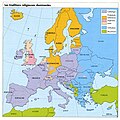Northern Europe
Northern Europe is a geographical and cultural region in the northern part of Europe. The term is used in a broad sense, encompassing the countries of Denmark, Finland, Iceland, Norway, and Sweden, as well as the United Kingdom, Ireland, the Baltic States (comprising Estonia, Latvia, and Lithuania), and parts of Russia.
Geography[edit]
Northern Europe is characterized by a relatively flat topography and a climate that ranges from a temperate maritime climate in the west to a subarctic climate in the north. The region is rich in natural resources, including oil, gas, and minerals, as well as forests and fish stocks.
History[edit]
The history of Northern Europe is marked by the influence of the Vikings, the spread of Christianity, the formation of nation-states, and the impact of the Industrial Revolution. In the 20th century, the region played a significant role in both World Wars and the Cold War.
Culture[edit]
Northern European culture is characterized by a strong emphasis on education, equality, and social welfare. The region is known for its high standard of living, progressive social policies, and strong commitment to environmental sustainability.
Economy[edit]
The economies of Northern Europe are among the most developed in the world. They are characterized by a high degree of industrialization, a well-developed infrastructure, and a strong emphasis on technology and innovation. The region is also known for its strong social safety nets and high levels of public spending.
See also[edit]
References[edit]
<references />
External links[edit]
|
|
|
-
Satellite image of Northern Europe
-
Köppen climate classification map of Europe
-
UN geoscheme subregion map of Europe
-
European regions according to EuroVoc
-
World Factbook subregion map of Europe
-
WGSRPD map of Northern Europe
-
Religions in Atlantic Europe
-
Map of the White Sea Canal
Ad. Transform your life with W8MD's Budget GLP-1 injections from $75


W8MD offers a medical weight loss program to lose weight in Philadelphia. Our physician-supervised medical weight loss provides:
- Weight loss injections in NYC (generic and brand names):
- Zepbound / Mounjaro, Wegovy / Ozempic, Saxenda
- Most insurances accepted or discounted self-pay rates. We will obtain insurance prior authorizations if needed.
- Generic GLP1 weight loss injections from $75 for the starting dose.
- Also offer prescription weight loss medications including Phentermine, Qsymia, Diethylpropion, Contrave etc.
NYC weight loss doctor appointmentsNYC weight loss doctor appointments
Start your NYC weight loss journey today at our NYC medical weight loss and Philadelphia medical weight loss clinics.
- Call 718-946-5500 to lose weight in NYC or for medical weight loss in Philadelphia 215-676-2334.
- Tags:NYC medical weight loss, Philadelphia lose weight Zepbound NYC, Budget GLP1 weight loss injections, Wegovy Philadelphia, Wegovy NYC, Philadelphia medical weight loss, Brookly weight loss and Wegovy NYC
|
WikiMD's Wellness Encyclopedia |
| Let Food Be Thy Medicine Medicine Thy Food - Hippocrates |
Medical Disclaimer: WikiMD is not a substitute for professional medical advice. The information on WikiMD is provided as an information resource only, may be incorrect, outdated or misleading, and is not to be used or relied on for any diagnostic or treatment purposes. Please consult your health care provider before making any healthcare decisions or for guidance about a specific medical condition. WikiMD expressly disclaims responsibility, and shall have no liability, for any damages, loss, injury, or liability whatsoever suffered as a result of your reliance on the information contained in this site. By visiting this site you agree to the foregoing terms and conditions, which may from time to time be changed or supplemented by WikiMD. If you do not agree to the foregoing terms and conditions, you should not enter or use this site. See full disclaimer.
Credits:Most images are courtesy of Wikimedia commons, and templates, categories Wikipedia, licensed under CC BY SA or similar.
Translate this page: - East Asian
中文,
日本,
한국어,
South Asian
हिन्दी,
தமிழ்,
తెలుగు,
Urdu,
ಕನ್ನಡ,
Southeast Asian
Indonesian,
Vietnamese,
Thai,
မြန်မာဘာသာ,
বাংলা
European
español,
Deutsch,
français,
Greek,
português do Brasil,
polski,
română,
русский,
Nederlands,
norsk,
svenska,
suomi,
Italian
Middle Eastern & African
عربى,
Turkish,
Persian,
Hebrew,
Afrikaans,
isiZulu,
Kiswahili,
Other
Bulgarian,
Hungarian,
Czech,
Swedish,
മലയാളം,
मराठी,
ਪੰਜਾਬੀ,
ગુજરાતી,
Portuguese,
Ukrainian











